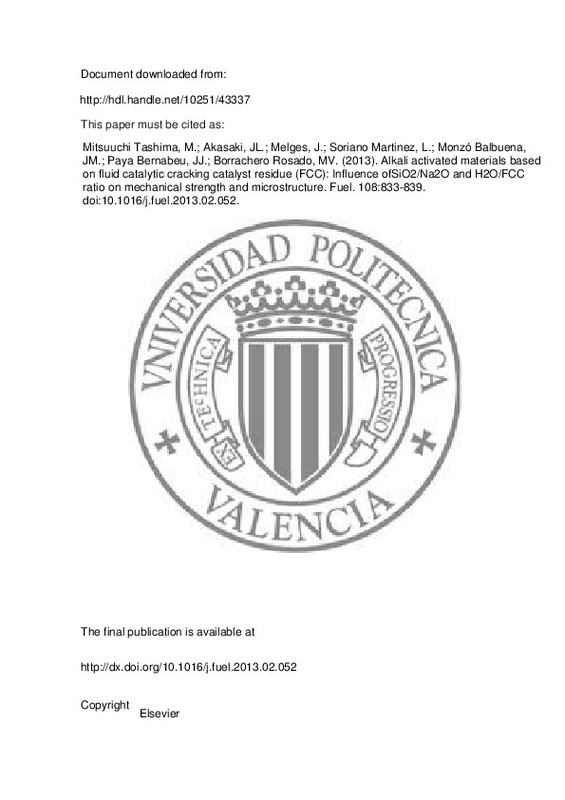JavaScript is disabled for your browser. Some features of this site may not work without it.
Buscar en RiuNet
Listar
Mi cuenta
Estadísticas
Ayuda RiuNet
Admin. UPV
Alkali activated materials based on fluid catalytic cracking catalyst residue (FCC): Influence ofSiO2/Na2O and H2O/FCC ratio on mechanical strength and microstructure
Mostrar el registro sencillo del ítem
Ficheros en el ítem
| dc.contributor.author | Mitsuuchi Tashima, Mauro
|
es_ES |
| dc.contributor.author | Akasaki, Jorge Luis
|
es_ES |
| dc.contributor.author | Melges, J.L.P.
|
es_ES |
| dc.contributor.author | Soriano Martínez, Lourdes
|
es_ES |
| dc.contributor.author | Monzó Balbuena, José Mª
|
es_ES |
| dc.contributor.author | Paya Bernabeu, Jorge Juan
|
es_ES |
| dc.contributor.author | Borrachero Rosado, María Victoria
|
es_ES |
| dc.date.accessioned | 2014-10-16T11:42:30Z | |
| dc.date.available | 2014-10-16T11:42:30Z | |
| dc.date.issued | 2013 | |
| dc.identifier.issn | 0016-2361 | |
| dc.identifier.uri | http://hdl.handle.net/10251/43337 | |
| dc.description.abstract | Reuse of industrial and agricultural wastes as supplementary cementitious materials (SCMs) in concrete and mortar productions contribute to sustainable development. In this context, fluid catalytic cracking catalyst residue (spent FCC), a byproduct from the petroleum industry and petrol refineries, have been studied as SCM in blended Portland cement in the last years. Nevertheless, another environmental friendly alternative has been conducted in order to produce alternative binders with low CO2 emissions. The use of aluminosilicate materials in the production of alkali-activated materials (AAMs) is an on going research topic which can present low CO2 emissions associated. Hence, this paper studies some variables that can influence the production of AAM based on spent FCC. Specifically, the influence of SiO2/Na2O molar ratio and the H2O/spent FCC mass ratio on the mechanical strength and microstructure are assessed. Some instrumental techniques, such as SEM, XRD, pH and electrical conductivity measurements, and MIP are performed in order to assess the microstructure of formed alkali-activated binder. Alkali activated mortars with compressive strength up to 80 MPa can be formed after curing for 3 days at 65 C. The research demonstrates the potential of spent FCC to produce alkali-activated cements and the importance of SiO2/Na2O molar ratio and the H2O/spent FCC mass ratio in optimising properties and microstructure. | es_ES |
| dc.description.sponsorship | Authors would like to thank to the Ministerio de Ciencia e Innovacion (MICINN) of the Spanish Government (BIA2011-26947) and to FEDER for funding, and also to the PROPG - UNESP "Universidade Estadual Paulista Julio de Mesquita Filho'', Brazil. | en_EN |
| dc.language | Inglés | es_ES |
| dc.publisher | Elsevier | es_ES |
| dc.relation.ispartof | Fuel | es_ES |
| dc.rights | Reserva de todos los derechos | es_ES |
| dc.subject | Spent FCC | es_ES |
| dc.subject | Waste | es_ES |
| dc.subject | Alkali activated material | es_ES |
| dc.subject | Mechanical properties | es_ES |
| dc.subject.classification | INGENIERIA DE LA CONSTRUCCION | es_ES |
| dc.title | Alkali activated materials based on fluid catalytic cracking catalyst residue (FCC): Influence ofSiO2/Na2O and H2O/FCC ratio on mechanical strength and microstructure | es_ES |
| dc.type | Artículo | es_ES |
| dc.identifier.doi | 10.1016/j.fuel.2013.02.052 | |
| dc.relation.projectID | info:eu-repo/grantAgreement/MICINN//BIA2011-26947/ES/REUTILIZACION DE RESIDUOS CERAMICOS Y DE DEMOLICION EN LA PREPARACION DE NUEVOS MATERIALES GEOPOLIMERICOS/ | es_ES |
| dc.rights.accessRights | Abierto | es_ES |
| dc.contributor.affiliation | Universitat Politècnica de València. Instituto de Ciencia y Tecnología del Hormigón - Institut de Ciència i Tecnologia del Formigó | es_ES |
| dc.contributor.affiliation | Universitat Politècnica de València. Departamento de Ingeniería de la Construcción y de Proyectos de Ingeniería Civil - Departament d'Enginyeria de la Construcció i de Projectes d'Enginyeria Civil | es_ES |
| dc.description.bibliographicCitation | Mitsuuchi Tashima, M.; Akasaki, JL.; Melges, J.; Soriano Martínez, L.; Monzó Balbuena, JM.; Paya Bernabeu, JJ.; Borrachero Rosado, MV. (2013). Alkali activated materials based on fluid catalytic cracking catalyst residue (FCC): Influence ofSiO2/Na2O and H2O/FCC ratio on mechanical strength and microstructure. Fuel. 108:833-839. https://doi.org/10.1016/j.fuel.2013.02.052 | es_ES |
| dc.description.accrualMethod | S | es_ES |
| dc.relation.publisherversion | http://dx.doi.org/10.1016/j.fuel.2013.02.052 | es_ES |
| dc.description.upvformatpinicio | 833 | es_ES |
| dc.description.upvformatpfin | 839 | es_ES |
| dc.type.version | info:eu-repo/semantics/publishedVersion | es_ES |
| dc.description.volume | 108 | es_ES |
| dc.relation.senia | 254047 | |
| dc.contributor.funder | Ministerio de Ciencia e Innovación | es_ES |
| dc.contributor.funder | European Regional Development Fund | es_ES |







![[Cerrado]](/themes/UPV/images/candado.png)

